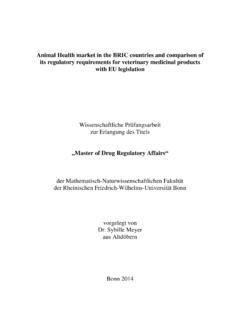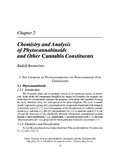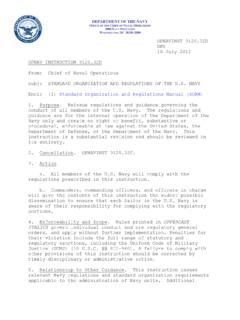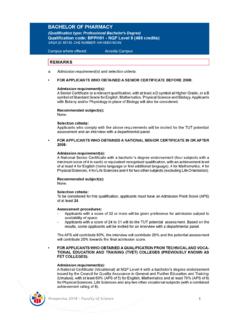Transcription of Implications of the new CHMP Guideline on the ...
1 Implications of the new CHMP Guideline on the Pharmaceutical Quality of Inhalation and Nasal Products Wissenschaftliche Pr fungsarbeit zur Erlangung des Titels Master of Drug Regulatory Affairs der Mathematisch-Naturwissenschaftlichen Fakult t der Rheinischen Friedrich-Wilhelms-Universit t Bonn vorgelegt von Dr. Herta Reile aus Eichst tt Bonn 2007 Betreuerin und 1. Referentin: Dr. Susanne Keitel Zweiter Referent: Dr. Usfeya Muazzam Dr. Herta Reile February 2007 3 Table of Content List of Abbreviations 4 1 introduction 5 2 Overview of Regulatory Environment in EU and US 7 3 New Guideline on Inhalation and Nasal Products 9 History of the Guideline 9 Scope 10 Content Overview 11 4 Changes in EU 18 5 Comparison of CHMP and FDA Requirements 22 6 Considerations for Future Harmonization 29 7 Summary 32 8 References 35 Dr. Herta Reile February 2007 4 List of Abbreviations CFC chlorofluorocarbon CMC chemistry, manufacturing and controls COPD chronic obstructive pulmonary disease DPI dry powder inhalers FDA Food and Drug Administration IPAC-RS International Pharmaceutical Aerosol Consortium on Regulation and Science JP Japanese Pharmacopoeia OIP orally inhaled products European Pharmacopoeia pMDI pressurized metered dose inhalation products QbD quality by design SmPC summary of product characteristics USP Pharmacopeia Dr.
2 Herta Reile February 2007 5 1 introduction medicinal products for inhalation consist of a great variety of technical systems and are used by a large number of patients, mainly with asthma or COPD. The advantage of inhalation products for these indications is the drug delivery directly to the site of action. At earlier times products for inhalation were mostly pressurized metered dose inhalers (pMDI) containing CFCs. Based on the Montreal Protocol, the international treaty regarding protection of the stratospheric ozone layer by determining the production and consumption of compounds that deplete ozone in the stratosphere ( chlorofluorocarbons (CFCs), halons) [1], the development of dry powder inhalers and non-CFC containing pressurized metered dose inhalers as replacements of CFCs containing products have been boosted.
3 In the meantime there is a great variety of technical systems on the market. Beside medicinal inhalation products used for asthma and COPD and for other lung diseases like locally acting antibiotics and antiviral drugs for lung infections, the development of innovative lung delivery devices was triggered by the findings on pulmonary delivery of drugs to the systemic system. Especially for drugs with low oral bioavailability inhalation therapy is an attractive route of administration bypassing the need for parenteral administration. Inhalation products and nasal products have been developed for systemic delivery via the lungs or nasal mucosa. Due to the advantages of nasal and pulmonary drug delivery over conventional drug delivery routes ( fast onset of action, avoidance of hepatic clearance, avoidance of GI digestion of proteins, improved convenience and compliance) these types of products gain growing importance [2].
4 The aspects of pharmaceutical quality of inhalation products are very complex since they generally consist of a drug product formulation together with a delivery device implicating many different parameters influencing product performance. First regulatory guidance on medicinal products for inhalation have been developed during the early 1990s in parallel by several competent authorities worldwide which had very divers views on risk assessment of such products [3]. As a consequence regulatory requirements for inhalation products vary significantly throughout the world. Since such complex medicinal products Dr. Herta Reile February 2007 6 are mostly developed for an international market divergence in regulatory requirements is a large drawback for product development. As an effort on harmonization as well as an update of existing regulatory requirements and in order to cover newer types of devices the new CHMP Guideline on the Pharmaceutical Quality of Inhalation and Nasal Products has been compiled and came into effect in the European Union on 1st, October 2006 [4].
5 As it was recognized that EU and Health Canada regulators have similar approaches to the assessment of these types of products the Guideline has been developed in collaboration with Health Canada since 2004 based on an already existing Canadian draft [5] and represents a harmonized Guideline for both regions [6]. Prior to this new Guideline there was no guidance on nebulisers and nasal sprays in the European Union. In this thesis the changes of regulatory requirements on pharmaceutical quality specific to inhalation products (pMDIs and DPIs) within the EU and the impact of this new Guideline on international drug development in this area are discussed. Topics with the need for further harmonization of requirements in EU/Canada and US are outlined. Other quality aspects generally to be considered for all kind of medicinal products are not addressed here. Further regulatory requirements and issues specific to medical devices in general [7, 8, 9] are out of scope of this thesis.
6 Dr. Herta Reile February 2007 7 2 Overview of Regulatory Environment in EU and US This is an overview of the current regulatory environment on pharmaceutical quality related requirements which are specific for inhalation and nasal medicinal products demonstrating the important position of the new Guideline . European Union The new CHMP Guideline on the Pharmaceutical Quality of Inhalation and Nasal Products [4] replaces the guidelines on pMDIs (CPMP Note for Guidance on Requirements for Pharmaceutical Documentation for Pressurised Metered Dose Inhalation Products) [10] and DPIs (CPMP Note for Guidance on Dry Powder Inhalers) [11] and is complementary to the CPMP Points to Consider on the Requirements for Clinical Documentation for Orally Inhaled Products (OIP) [12]. For detailed guidance on pharmaceutical development study designs ( , priming studies) and the analytical procedures used primarily for inhalation and nasal products ( , cascade impactor analysis) the Guideline refers to other publications ( , United States Pharmacopeia, European Pharmacopoeia, ISO standards [4].)
7 Further requirements on pharmaceutical quality like impurities, process validation, specifications, and stability testing are described in other EU guidance documents, including ICH guidelines. The European Pharmacopoeia which is legally binding includes several chapters regarding regulatory requirements for medicinal products administered nasal or by inhalation: Preparations for Inhalation ( :0671) [13] Preparations for Inhalation: Aerodynamic Assessment of Fine Particles ( :20918 corrected ) [14] (International harmonization with USP and JP [15, 16] Pressurised pharmaceutical preparations ( :0523) [17] Nasal Preparations ( :0676) [18] Dr. Herta Reile February 2007 8 USA The FDA has published the following Guidance for Industry which had been considered when drafting the new EU Guideline : Nasal Spray and Inhalation Solution, Suspension, and Spray Drug Products [19] Sterility Requirement for Aqueous-Based Drug Products for Oral Inhalation [20] Guidance for Industry on Integration of Dose-Counting Mechanisms into MDI Drug Products [21].)
8 There are two further guidance documents which, however, are still in draft: Draft Guidance for Industry on Metered Dose Inhaler (MDI) and Dry Powder Inhaler (DPI) Drug Products Chemistry, Manufacturing, and Controls Documentation, which is in draft status since October 1998 [22] Bioavailability and Bioequivalence Studies for Nasal Aerosols and Nasal Sprays for Local Action [23]. The USP ( Pharmacopeia) contains the following monographs regarding current requirements for medicinal products administered by inhalation: Aerosols, Metered-Dose Inhalers, and Dry Powder Inhalers, General Chapter <601> [24] (Particle size section under revision/ international harmonization) [15] Pharmaceutical Dosage Forms, General Chapter <1151> [25] The Biocompatibility of Materials used in Drug Containers, Medical Devices, and Implants, General Chapter <1031> [26] Minimum Fill, General Chapter <755> [27] Uniformity of Dosage Units, General Chapter <905> [28] However, the USP has not the status of law like the European Pharmacopoeia in EU and FDA s view is not necessarily in line with the USP.
9 Japan For Japan no specific guidance on orally inhaled and nasal drug products (OINDP) exists so far [29]. Dr. Herta Reile February 2007 9 3 New Guideline on Inhalation and Nasal Products History of the Guideline The need for revision and update of the previous CPMP Notes for Guidance on DPIs and pMDIs [11, 10] which came into force in December 1998 and October 2002, respectively, was addressed in a concept paper in April 2004 [6]. Recent significant international developments like the development of new dry powder inhalers, technological innovations in pMDIs, and a variety of single breath liquid systems (non-pressurized metered dose inhalers) needed to be reflected in regulatory guidelines. For nasal products, products for nebulisation, and hand-held nebuliser products no CPMP guidance was available. These developments have been included already in updated general chapters in the European Pharmacopoeia.
10 In the US the FDA had adopted one updated Guidance for Industry (July 2002) and released a second updated Guideline as draft (April 2003) in this area [19, 23]. The Draft Guidance for Industry Pharmaceutical Quality of Inhalation and Nasal Products released by Health Canada in November 2003 demonstrated that EU and Health Canada regulators have similar approaches to the assessment of these types of products [6]. This presented the opportunity of developing a harmonized guidance based on the Canadian draft for which the FDA guidance documents and EU guidelines and pharmacopoeial requirements had been considered and incorporated where applicable [16]. The EMEA Quality Working Party and Health Canada started the collaboration on a joint Guideline in May 2004 [30]. The first draft Guideline of this cooperation was published for consultation in February 2005.














